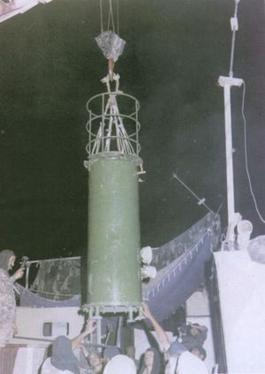
Back عملية بوخران الثانية Arabic पोखरण-2 Bihari পোখরান-২ Bengali/Bangla Operaatio Shakti Finnish Pokhran-II French पोखरण-2 Hindi インドの核実験 (1998年) Japanese 포카란 2차 핵 실험 Korean ഓപ്പറേഷൻ ശക്തി Malayalam पोखरण २ Marathi
| Pokhran-II Operation Shakti | |
|---|---|
 Shakti I prior to its detonation | |
| Information | |
| Country | India |
| Test site | Pokhran Test Range, Rajasthan |
| Coordinates | 27°04′44″N 71°43′20″E / 27.07889°N 71.72222°E |
| Period | 11–13 May 1998 |
| Number of tests | 3 (5 devices fired) |
| Test type | Underground |
| Device type | fission and fusion |
| Max. yield | 45 kilotons of TNT (190 TJ) |
| Test chronology | |
Pokhran-II (Operation Shakti) was a series of five nuclear weapon tests conducted by India in May 1998. The bombs were detonated at the Indian Army's Pokhran Test Range in Rajasthan. It was the second instance of nuclear testing conducted by India, after the first test, Smiling Buddha, in May 1974.
The test consisted of five detonations, the first of which was claimed to be a two-stage fusion bomb while the remaining four were fission bombs. The first three tests were carried out simultaneously on 11 May 1998 and the last two were detonated two days later on 13 May 1998. The tests were collectively called Operation Shakti, and the five nuclear bombs were designated as Shakti-I to Shakti-V.
The chairman of the Atomic Energy Commission of India described each of the explosions to be equivalent to several tests carried out over the years by various nations. While announcing the tests, the Indian government declared India as a nuclear state and that the tests achieved the main objective of giving the capability to build fission bombs and thermonuclear weapons with yields up to 200 kilotons. While the Indian fission bombs have been documented, the design and development of thermonuclear weapons remains uncertain after the tests.[1]
As a consequence of the tests, United Nations Security Council Resolution 1172 was enacted and economic sanctions were imposed by countries including Japan and the United States.
- ^ Kristensen, Hans M.; Korda, Matt; Johns, Eliana; Knight, Mackenzie (2 September 2024). "Indian nuclear weapons, 2024". Bulletin of the Atomic Scientists. 80 (5): 326–342. doi:10.1080/00963402.2024.2388470. ISSN 0096-3402. Retrieved 12 April 2025.
© MMXXIII Rich X Search. We shall prevail. All rights reserved. Rich X Search